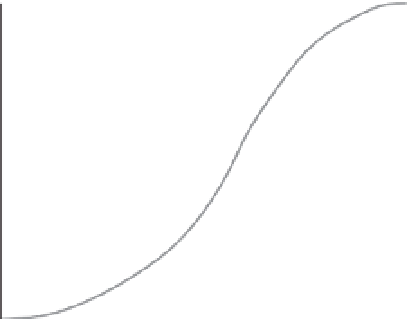Agriculture Reference
In-Depth Information
its yield. The management of pruning, of
the nitrogen supply, of the carbonic fertili-
zation and temperature allow translocation
of assimilates to be manipulated to the ben-
efit of the organs desired by the grower
(Urban, 1997a).
In young plants, the aim of controlling
the climate must be to get rapid formation of
leaf area to increase the potential for radia-
tion interception. In plants of determined
growth, the aim of climate control must be
to get the maximum amount of assimilates
going to the harvestable organs, whereas in
plants of undetermined growth climate con-
trol must aim for a balance in the distribu-
tion of assimilates between harvestable
organs and the rest of the plant (Marcelis
and De Koning, 1995).
0
0
Time
Fig. 6.9.
Growth of a plant's organ (sigmoid curve).
In the short term (at hour scale), plant
growth mainly depends on photosynthesis
and respiration (carbon balance) and on the
water status of the plant. In the long term,
the productive process is determined by the
accumulation of dry matter, by the develop-
ment stage of the plant, by the distribution
of this dry matter to the harvestable organs
and by the quality of the produce (Challa
et al
., 1995).
6.7
Growth
6.7.1
Introduction
There are several ways of measuring growth:
at an elementary level by variation in the
dimensions of a leaf or of an internode; or at
a more complex level by measuring a stem
or whole plant, as well as measurements
taken over different time scales.
Measurements of weight usually con-
sider dry matter (which does not have the
level of variability of fresh matter) requiring
the destruction of the samples. So, repre-
sentative samplings must be taken, with the
aim of having accurate and comparable
measurements.
Crop growth, in general, follows the
pattern of a sigmoid curve (Fig. 6.9). Initially,
when plants are young and the limiting fac-
tor is the interception of radiation (low leaf
area), growth is exponential. When leaf area
increases, the interception of radiation is
less dependent on the leaf area, and growth
is approximately linear. Finally, as senes-
cence approaches, growth slows down.
In complex organs, such as a stem com-
posed of many internodes, each internode
has its own kinetic, but the sum of the ele-
mental growth keeps the sigmoid pattern
(Berninger, 1989).
6.7.2
Influence of the microclimate
on growth
All the climate factors interact with the
crop. The greatest effect of radiation is on
photosynthesis. The influence of temper-
ature depends on the age of the plant; in
young plants, its influence on leaf expan-
sion, necessary to maximize the inter-
ception of radiation, is essential. For this
reason, in the first stages of development
it is necessary to optimize the temp-
erature, to achieve rapid leaf develop-
ment. Later, with well-developed crops
the main role of temperature is on
respiration.
The positive effect of CO
2
on growth
has been widely documented in C3 type
plants (Kimball, 1986) with an average
increase in yield of 30% at 1000 ppm of
CO
2
; levels of CO
2
supplementation greater
than 1000 ppm is not recommended
because of cost considerations but also

